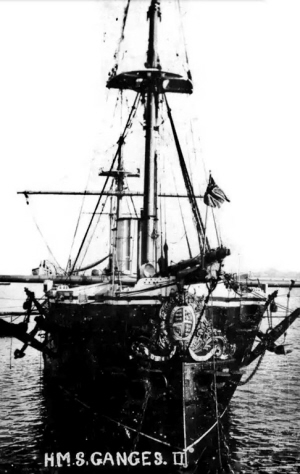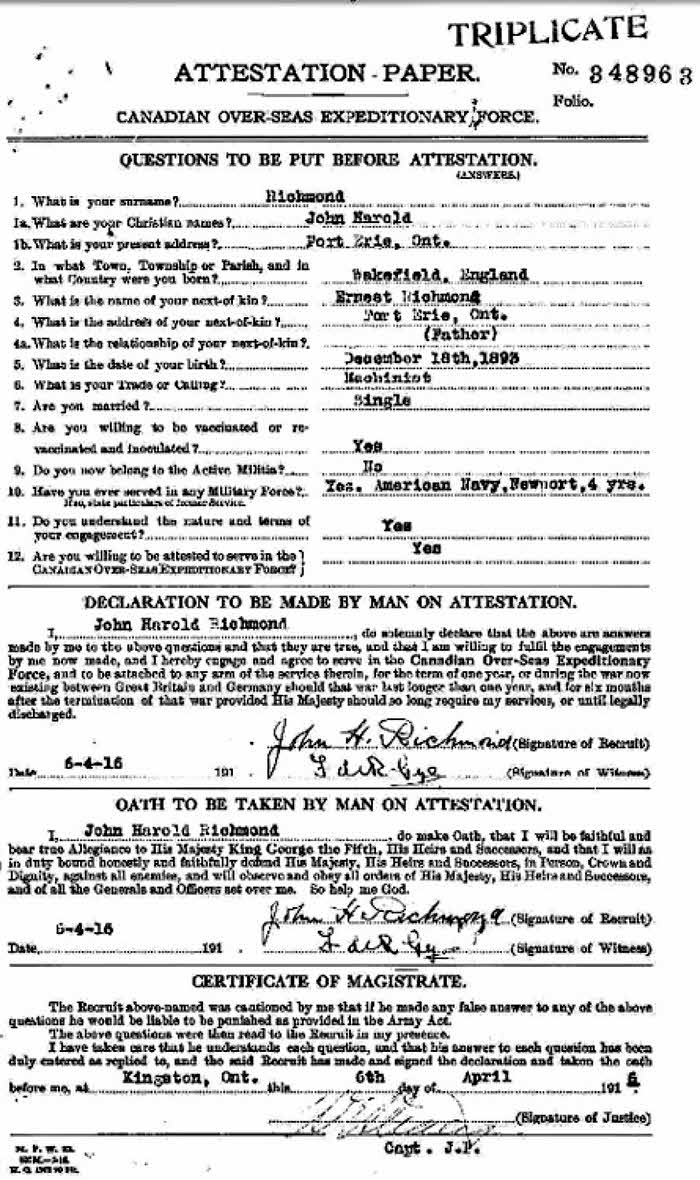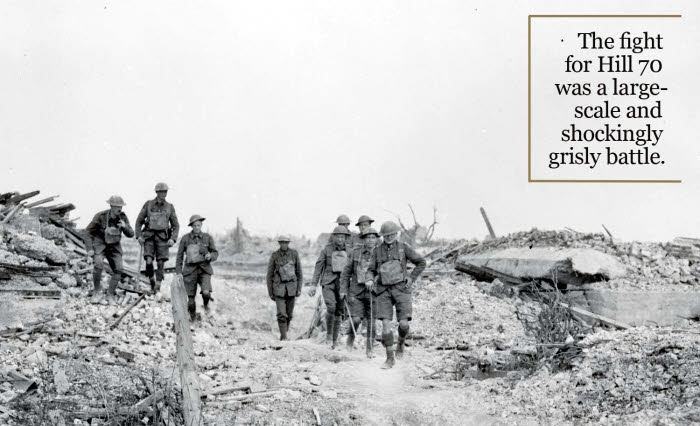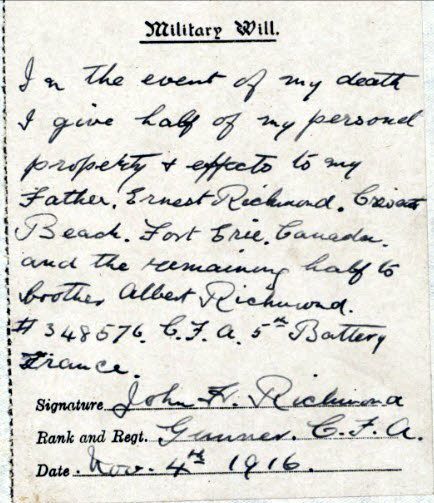
348963, 9th Brigade, Canadian Field Artillery
John Harold Richmond was born on Dale Street, Ossett on the 18th December 1892. His birth was registered at Dewsbury in early 1893. He was baptised at Holy Trinity Church Ossett on the 2nd July 1893. He was the eldest son of Ernest Richmond and his wife Minnie (nee Bothwick) who married on the 3rd September 1892 at Holy Trinity Church, Ossett. At the time of his marriage, Ernest, then working as a gardener was 20 years of age and his wife Minnie was 27 years of age. The Richmond family, including John Harold and his younger brother Albert, lived on Intake Lane in 1901.
On his 18th birthday, December 18th 1910, John H. Richmond enlisted in the Royal Navy, signing up for 12 years service. John began his naval career at HMS Ganges ll, the overflow for the Royal Naval Training School, HMS Ganges.
 Left: HMS Ganges II at the time John Harold Richmond joined the Royal Navy.
Left: HMS Ganges II at the time John Harold Richmond joined the Royal Navy.
Four months later, at the time of the 1911 Census, John Harold Richmond was an Ordinary Seaman aboard the HMS Caernarvon, anchored in Torbay.
It is not yet known when Ernest Richmond and his sons left Ossett for Canada, but they did leave Ossett and this explains why both sons enlisted in the Canadian Army. Ernest’s wife Minnie had sadly died at the early age of 39 in late 1905. Perhaps the loss of Minnie was the reason for Ernest Richmond to seek a new life in Canada.
Minnie and Ernest’s youngest son, Albert, was born in Ossett on the 2nd of September 1895. In September 1915, he joined the Canadian Overseas Expeditionary Force and arrived in England on the 12th of April 1916. He was stationed at Shornecliffe Army Camp until the 3rd of October 1916 when he embarked for France. His service number was 348576 and he served with the Canadian Field Artillery. He was promoted to acting bombardier in August 1918; confirmed in December 1918. After the end of the war he “proceeded to England” on the 18th of March 1919 and returned to Canada on the 12th of April 1919. He was discharged from service on the 23rd of April 1919. By the time of his discharge on the 23rd of April 1919, Albert Richmond had risen to the rank of bombardier.
In April 1916 his brother John Harold Richmond also joined the Canadian Overseas Expeditionary Force and served with the Canadian Field Artillery with service number 348963. About 630,000 Canadians enlisted in the Canadian Expeditionary Force between 1914 and 1918. Soldiers, nurses, doctors, and forestry and railway crews. More than 234,000 were killed or wounded in the war. Most of them were volunteers.

Above: The attestation document for John Harold Richmond, which was signed on the 6th of April 1916 at Kingston, Ontario. Interestingly his date of birth was given as the 18th of December 1893, which may simply have been a mistake. He was single and described as a machinist living at the Port Erie, Ontario, the home of his widowed father Ernest. The Attestation records that he had served in the American Navy at Newport, Rhode Island, USA for 4 years. Did the Richmond family emigrate first to the USA before later moving on to Canada?
The dates suggests that John Harold probably emigrated after early April 1911, when he was recorded serving in the British Navy. His final day of service with the Royal Navy was said to be the 27th of December 1913, when he served at HMS Monmouth.
John Harold was 23 years and 3 months of age, weighing 128 lbs and 5’5” tall with a medium complexion blue eyes and brown hair. His religion was Church of England. He embarked Canada on the 16th July 1916 and arrived in England with the Canadian Expeditionary Force on 25th July 1916. Like his younger brother, Albert, who arrived in England in April 1916, John Harold was stationed at Shornecliffe Army Camp near Cheriton Kent, which served as a staging post for troops destined for the Western Front during the First World War. Its closure was announced in 2016.
 John Harold was made acting bombardier on the 6th of October 1916, the day his brother embarked from Shorecliffe for France. At his own request, John Harold reverted to the ranks on the 11th November 1916 whilst still at Shornecliffe Camp. He and his brother would have been together in the Camp between mid July and early October 1916.
John Harold was made acting bombardier on the 6th of October 1916, the day his brother embarked from Shorecliffe for France. At his own request, John Harold reverted to the ranks on the 11th November 1916 whilst still at Shornecliffe Camp. He and his brother would have been together in the Camp between mid July and early October 1916.
He arrived in France on the 13th of November 1916 and was in the field two days later. By the 28th August 1917, Private John Harold Richmond was a gunner with the 9th Brigade of the Canadian Field Artillery. He was admitted on that day to No. 22 General Hospital at Dannes, Camiers, 22 km south of Boulogne.
On the 1st September 1917 he was reported as dangerously ill following gun shot wounds and shell gas poisoning. The record shows he died of his wounds on the 3rd September 1917 whilst serving with the ‘C’ Battery RCHA (Royal Canadian Horse Artillery). The record reveals that Ottowa was cabled with the sad news two days later. John Harold’s father had died on August 5th, just two weeks earlier. He was 46 years of age. Now his widow, Sarah, had more unimaginable tragedy to bear.
348963 Gunner John Harold Richmond, son of Minnie and Ernest, stepson of Sarah, of Queen Street, Ontario and formerly of Ossett, died on the 3rd September 1917 of wounds received in battle in France. He is buried at Etaples Military Cemetery, Pas de Calais, France. Grave Reference: XXV. O. 12A.
The inscription on his headstone reads:
“THY WILL BE DONE THE STORM IS PASSED THE FIELD IS WON”
In addition, this modest headstone stands in Greenwood Cemetery, Fort Erie in Ontario, Canada. As we can see it is a memorial to Ernest Richmond, his son John Harold Richmond and Ernest’s second wife Sarah Cole Richmond.

It is likely that John Harold Richmond was wounded in the Battle of Hill 70 on the outskirts of Lens, which began in mid August 1917. The objectives were to inflict casualties and to draw German troops away from the 3rd Battle of Ypres and to make the German hold on Lens untenable. The Canadian Corps objective was to capture Hill 70 and then establish defensive positions to repel German counter-attacks and inflict as many casualties as possible. The Canadian Corps were only partially accomplished and a later attempt to extend its position into the city of Lens failed to materialise but succeeded in its attritional objective. The battle was costly for both sides and many casualties were suffered from extensive use of poison gas, including the new German Yellow Cross shell containing the blistering agent sulphur mustard (mustard gas).

Above: The Military Will of John Harold Richmond, dated the 4th November 1916.
Gunner John Harold Richmond served his own country in the Royal Navy, then served with the United States Navy and finally with the Canadian Field Artillery as a volunteer. He died at the age of 24 years fighting for his country and as an Ossett man should be remembered for his sacrifice.
This biography can only give us a small insight into the life of John Harold Richmond and that of his family, but he will be remembered.

Commonwealth War Graves Commission Headstone (Photograph courtesy of Mark Smith)
References:
1. Ossett Through The Ages and The Ossett Fallen WWI & WWII Facebook Groups.